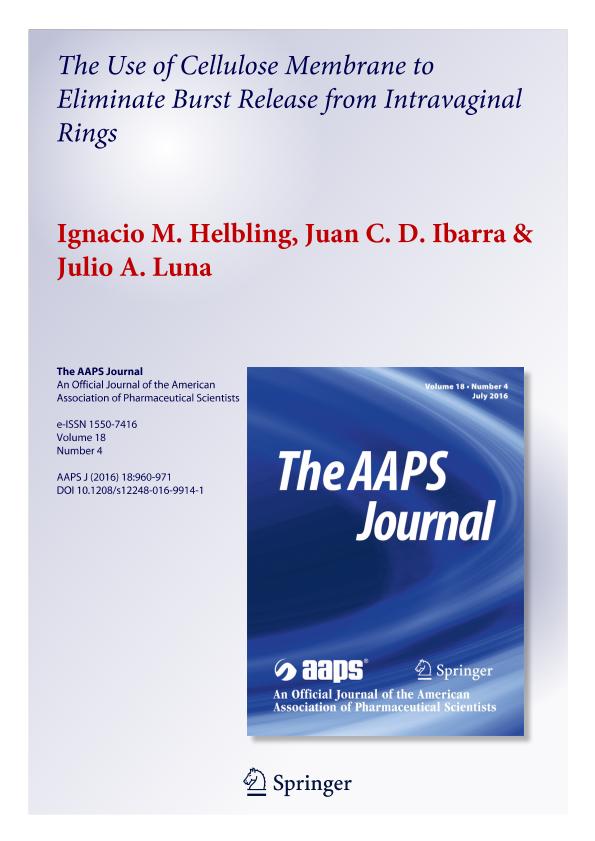Mostrar el registro sencillo del ítem
dc.contributor.author
Helbling, Ignacio Marcelo

dc.contributor.author
Ibarra, Juan Carlos Daniel

dc.contributor.author
Luna, Julio Alberto

dc.date.available
2017-09-07T20:30:19Z
dc.date.issued
2016-04
dc.identifier.citation
Helbling, Ignacio Marcelo; Ibarra, Juan Carlos Daniel; Luna, Julio Alberto; The Use of Cellulose Membrane to Eliminate Burst Release from Intravaginal Rings; Springer; Aaps Journal; 18; 4; 4-2016; 960-971
dc.identifier.issn
1550-7416
dc.identifier.uri
http://hdl.handle.net/11336/23822
dc.description.abstract
Burst release was observed when ethylene vinyl acetate copolymer (EVA) intravaginal rings were tested for progesterone release in our previous work (Helbling et al. Pharm Res. 31(3):795–808, 2014). Burst release is undesirable in controlled delivery devices because release is uncontrollable and higher levels of active pharmaceutical ingredient could lead to the occurrence of adverse effect. The present contribution is about the use of membranes to coat EVA rings to eliminate burst release. Physicochemical state of progesterone in uncoated rings and the solubility and diffusion coefficient in membrane were studied. Hormone delivery from several rings of different sizes was compared. A mathematical model was used to analyze the effects of membrane properties on delivery rate. No chemical interactions were detected between hormone and polymer. Hormone was mainly forming amorphous aggregates inside rings, and migration to membrane was not observed during storage. Diffusion coefficient was smaller in membrane (~10-8 cm2 s-1) than in matrix (~10-7 cm2 s-1). Zero-order release kinetics were obtained for coated rings, and release rate decreases as the thickness of the coat increases. Cellulose membrane successfully eliminates burst release and controls the delivery from EVA rings. The equations developed can be used to determine the appropriate coat thickness to produce specific release rate.
dc.format
application/pdf
dc.language.iso
eng
dc.publisher
Springer

dc.rights
info:eu-repo/semantics/openAccess
dc.rights.uri
https://creativecommons.org/licenses/by-nc-sa/2.5/ar/
dc.subject
Burst Release
dc.subject
Cellulose Membrane
dc.subject
Drug Delivery
dc.subject
Intravaginal Rings
dc.subject
Progesterone
dc.subject.classification
Otras Ingeniería Química

dc.subject.classification
Ingeniería Química

dc.subject.classification
INGENIERÍAS Y TECNOLOGÍAS

dc.title
The Use of Cellulose Membrane to Eliminate Burst Release from Intravaginal Rings
dc.type
info:eu-repo/semantics/article
dc.type
info:ar-repo/semantics/artículo
dc.type
info:eu-repo/semantics/publishedVersion
dc.date.updated
2017-09-01T18:24:23Z
dc.journal.volume
18
dc.journal.number
4
dc.journal.pagination
960-971
dc.journal.pais
Alemania

dc.journal.ciudad
Berlin
dc.description.fil
Fil: Helbling, Ignacio Marcelo. Consejo Nacional de Investigaciones Científicas y Técnicas. Centro Científico Tecnológico Conicet - Santa Fe. Instituto de Desarrollo Tecnológico para la Industria Química. Universidad Nacional del Litoral. Instituto de Desarrollo Tecnológico para la Industria Química; Argentina
dc.description.fil
Fil: Ibarra, Juan Carlos Daniel. Consejo Nacional de Investigaciones Científicas y Técnicas. Centro Científico Tecnológico Conicet - Santa Fe. Instituto de Desarrollo Tecnológico para la Industria Química. Universidad Nacional del Litoral. Instituto de Desarrollo Tecnológico para la Industria Química; Argentina
dc.description.fil
Fil: Luna, Julio Alberto. Consejo Nacional de Investigaciones Científicas y Técnicas. Centro Científico Tecnológico Conicet - Santa Fe. Instituto de Desarrollo Tecnológico para la Industria Química. Universidad Nacional del Litoral. Instituto de Desarrollo Tecnológico para la Industria Química; Argentina
dc.journal.title
Aaps Journal

dc.relation.alternativeid
info:eu-repo/semantics/altIdentifier/doi/http://dx.doi.org/10.1208/s12248-016-9914-1
dc.relation.alternativeid
info:eu-repo/semantics/altIdentifier/url/https://link.springer.com/article/10.1208%2Fs12248-016-9914-1
Archivos asociados
